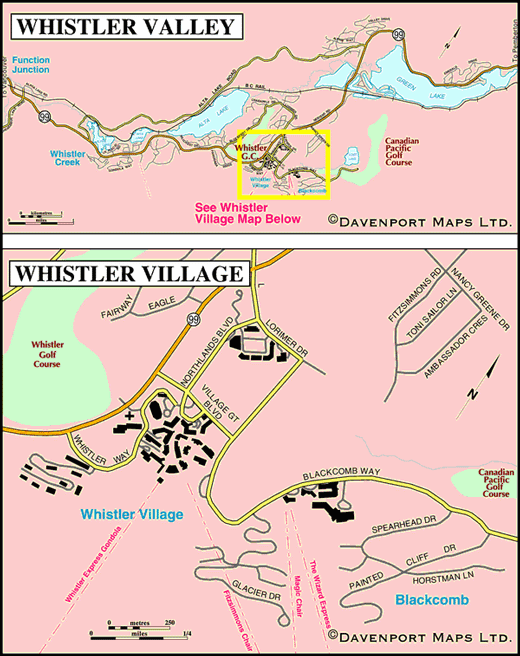Carve your own tracks through deep, dry fresh powder and the breathtaking scenery of glaciers and subalpine glades. The deep blue sky, calm conditions and comfortable temperatures enhance the great powder experience of heli-skiing Whistler and Blackcomb Mountains in Whistler, north of Vancouver in British Columbia.
High-fives, glowing faces and broad smiles are testament to the ecstasy of heli-skiing these magical peaks, open bowls, glades and tree-lined chutes, where mind, body, snow and mountain all become one, providing the ultimate high-alpine experience.
This ultimate skiing and snowboarding experience is no longer the preserve of expert skiers, with new fat boy powder skis and refined snowboards making it possible for intermediates to float on the powder and delight in the amazing experience of heli-skiing.
British Columbia offers some of the best heli-skiing in the world and is home to 80% of the world’s heli-skiing operations. Heli-Skiing companies in BC are licensed to heli-ski in defined regions by the government of British Columbia.
Heli-ski Areas
The wilderness environment just beyond the lifts to the east, north, and west of Whistler Blackcomb Ski Resort offers hundreds of ski runs, with a tremendous variety of slopes to accommodate all levels of skiers and boarders, from intermediate to expert. Heli-skiing provides access to the hundreds of runs accessible only by helicopter. The runs vary from expansive glaciers to beautiful subalpine open-tree runs, depending on the weather conditions, and vary from 1,400 to 5,000 vertical feet (400m to 1,500m), with the average runs being approximately 45 minutes. The range includes 7,500-ft Spearhead (behind Blackcomb), 9,000-ft Ipsoot Mountain (north of Whistler), 7,200-ft Powder Mountain (south west of Whistler Village), and 9,300-ft Feethurley River Area (north of Pemberton).
The availability of Heli-Skiing at Whistler Blackcomb significantly increases Whistler Blackcomb’s skiable terrain, and offers guests over half a million acres of skiing and snowboarding terrain. The addition of Heli-Skiing’s tenure of 494,000 acres throughout the Whistler backcountry to Whistler Blackcomb’s 8,171 acres of in-bounds skiing, creates a ski area of 502,171 acres, or 785 square miles.
Snow Conditions
Snow conditions vary considerably over winter and change almost daily. Whistler generally receives frequent snowfalls, producing good powder snow conditions. There is always some level of avalanche danger in the mountains. When the danger of avalanche is high, safer runs with 30-degree slopes are selected, as opposed to the steeper 40-degree slopes skied under safer conditions. As a safety measure, skiers should never ski below the guide. Safety is always the guides’ primary concern.
Skill Level
Heli-skiers and snowboarders need to be of intermediate or better ability, and are normally grouped according to skill level by the heli-ski company. This will allow skiers to join a group of matching experience. Two guides normally accompany each group, selecting terrain suitable for the ability of the group and enabling the better skiers to descend at their preferred pace. Heli-skiing is more strenuous than conventional skiing, so you need to be certain that you can manage multiple days heli-skiing before committing yourself to a week-long heli-ski camp. Sign up for a day of heli-skiing first to get an idea of how taxing it is – and how exciting it can be.
Equipment and Gear
Powder skis are wider under the boot than most other skis, and generally shorter than regular skis. In very deep powder, true powder skis make a huge difference, as fat-boy powder skis provide extra stability in the backcountry. The big platform underfoot helps intermediates remain balanced in deep snow, and the fat tips keep skiers from submarining by providing maximum flotation in deep powder. Skiers should bring their own ski poles and ski boots, which can easily be fitted to rental skis. Snowboarders prefer a longer, wider, and softer snowboard for powder snow. Short carving boards and long narrow racing boards are not suitable for heli-boarding. Your snowboard should come up at least to your nose. Specialized bindings can usually be transferred to rental snowboards. Powder skis and snowboards are available for rental in Whistler, and are issued to match your skill level and the current snow conditions to ensure that you ski with the right equipment. Heli-skiers are provided with an avalanche transceiver to strap under their parkas, and “powder cords” or “ski tracers”, certain lifesavers in the event of an avalanche. Your guide will teach you how to locate buried signals in the snow.
Guides
Heli-ski guides monitor snow and weather conditions on a daily basis, they will test the stability of the snow pack and select the best ski area for the day based on the wind, temperature, and recent snowfalls. The guides know their way around the many ravines, shoots, and faces of each glacier to be skied, and carry heavy packs with crevasse rescue gear like ropes, harnesses, and webbing; as well as avalanche rescue gear and overnight survival gear. Heli-ski guides are certified with numerous organizations, including the Canadian Avalanche Association, the Association of Canadian Mountain Guides, and the Canadian Ski Guide Association. All guides have completed avalanche courses, and are competent in first, mountaineering, rope handling and rescue procedures. Instructions dealing with safety around helicopters are also given.
Heli-Skiing Season
Heli-skiing is run from December to April, with the best months February and March, when weather and snow conditions are normally the most reliable. The colder weather in January often provides good heli-skiing conditions, and late March and April offer longer days to enjoy great spring skiing conditions.




